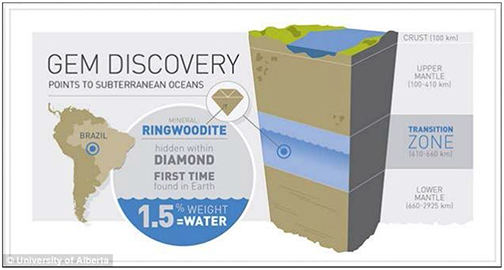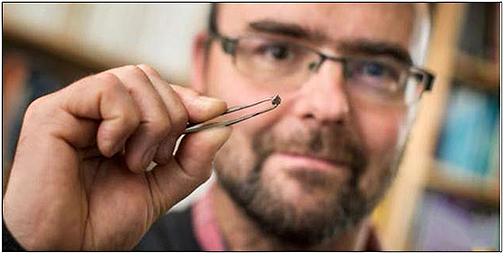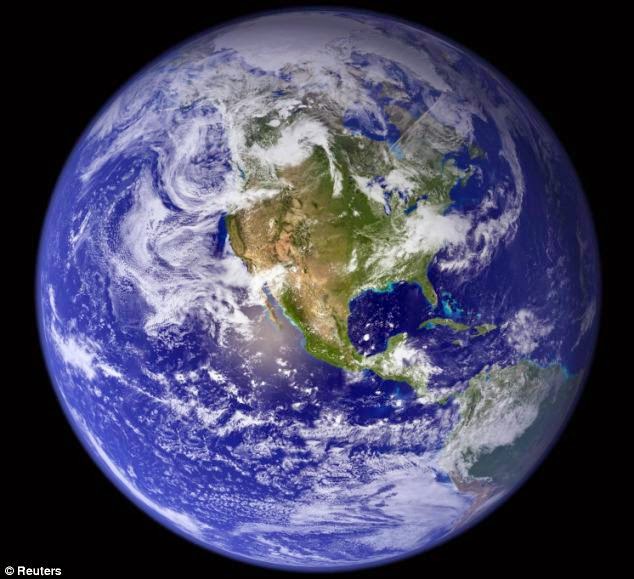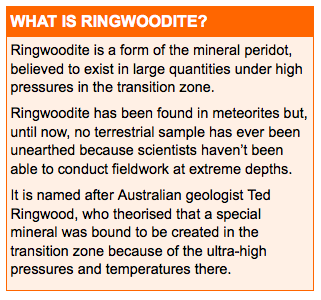| Online: | |
| Visits: | |
| Stories: |

| Story Views | |
| Now: | |
| Last Hour: | |
| Last 24 Hours: | |
| Total: | |
Revealed: The vast reservoir hidden beneath the Earth’s crust that holds as much water as ALL of the oceans
Musings On The Finite Statist Machine
A bit of back handed disclosure? -AK
Revealed: The vast reservoir hidden beneath the Earth’s crust that holds as much water as ALL of the oceans
Believed to be 400-600 kilometres (250-375 miles) beneath our feet 1.5 percent of the rock analysed comprises molecules of water. First time researchers have ever found ringwoodite, a mineral in the
Earth’s mantle – after discovering it in a $20 diamond Researchers say discover could have a ‘profound’ effect on our understanding on Earth.
By MARK PRIGG
PUBLISHED: 22:36 GMT, 12 March 2014 | UPDATED: 14:21 GMT, 13 March 2014
Scientists have discovered a vast reservoir of water under the Earth’s mantle they say could be larger
than all the ocean’s combined.
Canadian researchers say analysis of a rare mineral points to the huge store of water deep in Earth’s
mantle, 400-600 kilometres (250-375 miles) beneath our feet.
It echoes the hundred and fifty year old novel, ‘Journey to the Centre of the Earth’, in which French
science-fiction forerunner Jules Verne pictured a vast sea that lay deep under our planet’s surface.
The evidence comes from a water-loving mineral called ringwoodite that came from the so-called
transition zone sandwiched between the upper and lower layers of Earth’s mantle, they said in
the journal Nature.
Analysis shows that 1.5% of the rock comprises molecules of water. The find backs once-contested theories that the transition zone, or at least significant parts of it, is water-rich, the investigators said.
‘This sample really provides extremely strong confirmation that there are local wet spots deep
in the Earth in this area,’ said Graham Pearson of Canada’s University of Alberta, who led the research.
‘That particular zone in the Earth, the transition zone, might have as much water as all the world’s oceans put together.’
Ringwoodite is named after Australian geologist Ted Ringwood, who theorised that a special mineral
was bound to be created in the transition zone because of the ultra-high pressures and temperatures
there.
A piece of this mineral has been a long-sought goal.
 |
|
Where it is: Researchers say the ringwoodite reveals the Earth’s transition zone could be a vast reservoir of water
|
It would resolve a long-running debate about whether the poorly-understood transition zone is bone dry or water-rich.
But, until now, ringwoodite has only ever been found in meteorites.
Geologists had simply been unable to delve deep enough to find any sample on Earth.
Good fortune, though, changed all this.
In 2008, amateur gem-hunters digging in shallow river gravel in the Juina area of Mato Grasso, Brazil, came across a tiny, grubby stone called a brown diamond.
 |
|
Graham Pearson holds the first terrestrial sample of ringwoodite ever found – which led to the discovery
|
Measuring just three millimetres (0.12 inches) across and commercially worthless, the stone
was acquired by the scientists when they were on a quest for other minerals.
But the accidental acquisition turned out to be a bonanza.
In its interior, they found a microscopic trace of ringwoodite — the very first terrestrial evidence of the ultra-rare rock.
‘It’s so small, this inclusion, it’s extremely difficult to find, never mind work on,’ Pearson said in a press release, paying tribute to the diligent work of grad student John McNeill.
‘It was a bit of a piece of luck, this discovery, as are many scientific discoveries.’
The team theorise that the brown diamond rocketed to the surface during a volcanic eruption, hitchhiking in a stream of kimberlite, the deepest of all volcanic rocks.
Years of analysis, using spectroscopy and X-ray diffraction, were needed in specialised labs to confirm the find officially as ringwoodite.
Scientists have debated for decades about whether the transition zone has water, and if so, how much
of the precious stuff there might be.
None, though, has embraced Verne’s fancy of a subterranean sea with a rocky coastline dotted with
forests of giant mushrooms and petrified trees
Kind of goes with this:
https://coseinspiegabilidelmondoediroma.wordpress.com/agharti/
![agharta_arcadia[1]](https://coseinspiegabilidelmondoediroma.files.wordpress.com/2012/05/agharta_arcadia1.jpg?w=593) The entrances are secured by illusory technology that is beyond the comprehension of modern science and humankind but it are believed to be:
The entrances are secured by illusory technology that is beyond the comprehension of modern science and humankind but it are believed to be:- Mato Grosso,Brazil;
- Mount Epomeo , Italy;
- Lake Bracciano,Italy
- Gobi Desert Mongolia;
- Great Pyramid of Giza.
Source: http://americankabuki.blogspot.com/2014/12/revealed-vast-reservoir-hidden-beneath.html






![agharta[1]](https://coseinspiegabilidelmondoediroma.files.wordpress.com/2012/05/agharta11.jpg?w=593&h=615)
![shambhalacity[1]](https://coseinspiegabilidelmondoediroma.files.wordpress.com/2012/05/shambhalacity1.jpg?w=593)